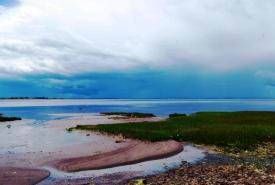Grand Barachois

Barachois, New Brunswick (Photo by NCC)
The Nature Conservancy of Canada’s (NCC's) nature reserve in Grand Barachois is on the Northumberland Strait in the rural community of Beaubassin Est, approximately five kilometres from the town of Shediac.
NCC has been working in this area since 2003 thanks to four land donations. Three of these sites were gifted to NCC by the late Dr. Roland Maurice, who donated 17 hectares (41 acres) for conservation.
Dr. Roland Maurice
Dr. Roland Maurice grew up on a farm in Bouctouche, New Brunswick, where he first developed a passion for medicine. In 1965, he became the only ear microsurgeon in the east of the country at the time, conducting four or five stapedectomies per week. Subsequently, he invested much time — 25 years of volunteering — to the creation of support programs for students with financial problems. He established the Scholarship Fund Clément-Richard in 1977, and was the fund's president for two decades.
Dr. Maurice's work in microsurgery increased his dexterity for his second passion — sculpting. After his retirement, Dr. Maurice started stone carving.
Nature is Dr. Maurice's source of inspiration. The fauna and flora of New Brunswick was of interest to him — and that is why he wanted to donate his land to the Nature Conservancy of Canada.
“We used to have so many terns and other birds next to this property but with the four-wheelers in the sand and the damage, I just couldn’t digest that,” said Dr. Maurice in 2011. “Something had to be done about it. This is an important project by the Nature Conservancy of Canada and my family is excited about it. I did not want to lose all those birds that come and nest every spring and are part of the area.”
Grand Barachois at a glance
The Nature Conservancy of Canada is preserving dynamic dune systems subject to rapid change along Northumberland Strait. The seaside dune in Grand Barachois provides a barrier beach for the other part of the nature reserve which contains a small salt marsh.
The donated properties have coastal hardwood trees (red oak) that used to be abundant in the area but are now uncommon along this stretch of Northumberland Strait coast.
Conservation values
The predominant vegetation in the dune system is sea lyme grass.
This sandy beach provides potential habitat for the nationally endangered piping plover, a migratory shorebird that breeds in eastern and central Canada.
The NCC property also contains a salt marsh, many tidal channels and pools. Threespine stickleback and mummichog can be found in these small pools.
Many different species of waterfowl also use the area for breeding and staging, including American black ducks. Great blue herons and osprey fish in the ponds and eastern coyotes as well as white-tailed deer are also found here.
Threats
The moderate climate makes the Northumberland Strait a popular recreational area. Pressures from cottage development are increasing rapidly. As a result of agricultural and residential development, 65 per cent of all the salt marshes originally found in Atlantic Canada have been lost.
Because of the warm waters and the sandy beaches, the surrounding area is a very popular tourist attraction during the summer months.
Support
In addition to the generosity of Dr. Maurice and his family, along with another anonymous land donor, the Nature Conservancy of Canada acknowledges funding support from the Government of Canada’s Natural Areas Conservation Program (Environment Canada) along with Government of New Brunswick through the Regional Development Corporation.
Our vision for Barachois
Our goal is to protect the barrier beach and the small salt marsh complex located in the Grand Barachois Focal Area. We have engaged the local community. NCC staff accompanies local residents and volunteers for monitoring tours that provide updated reports on the ecological status of the properties.




